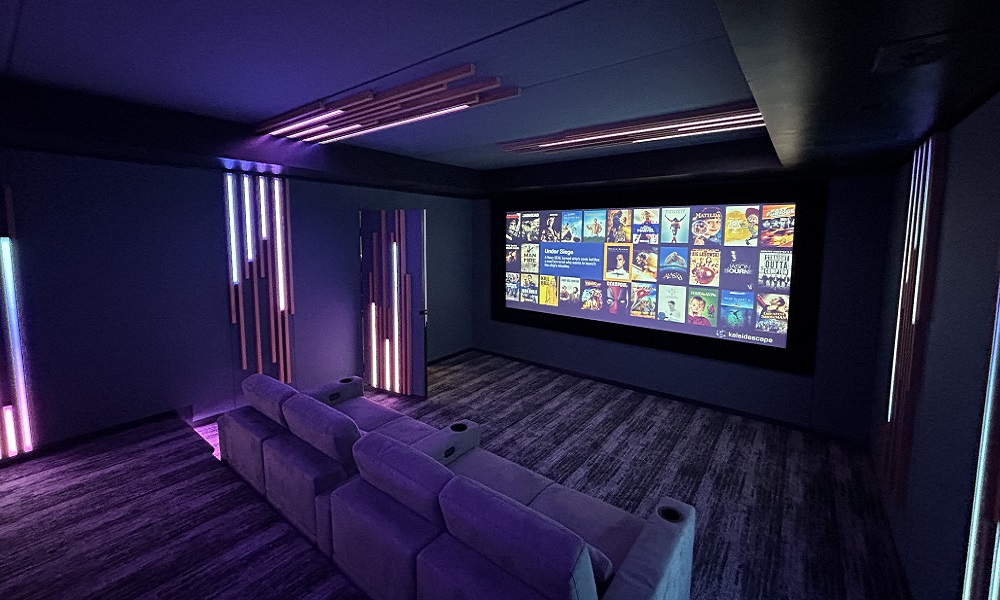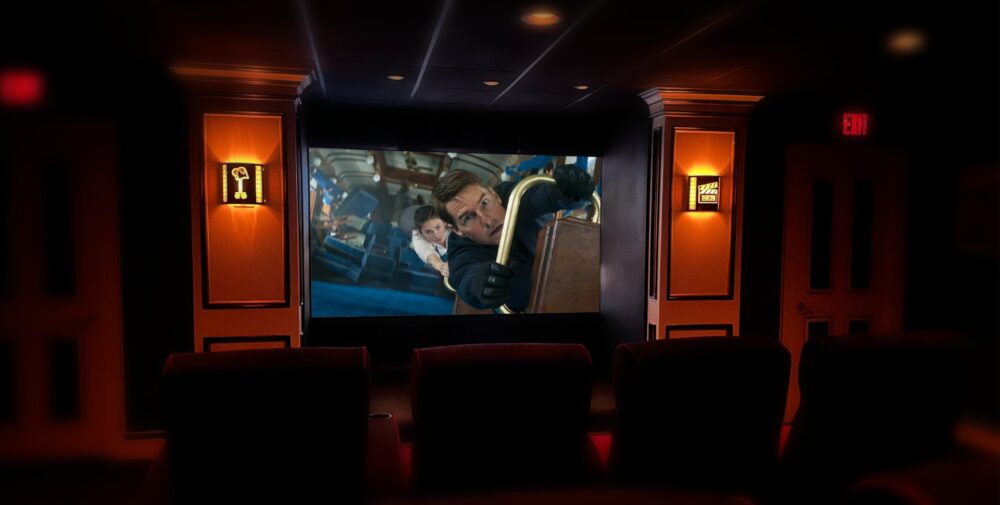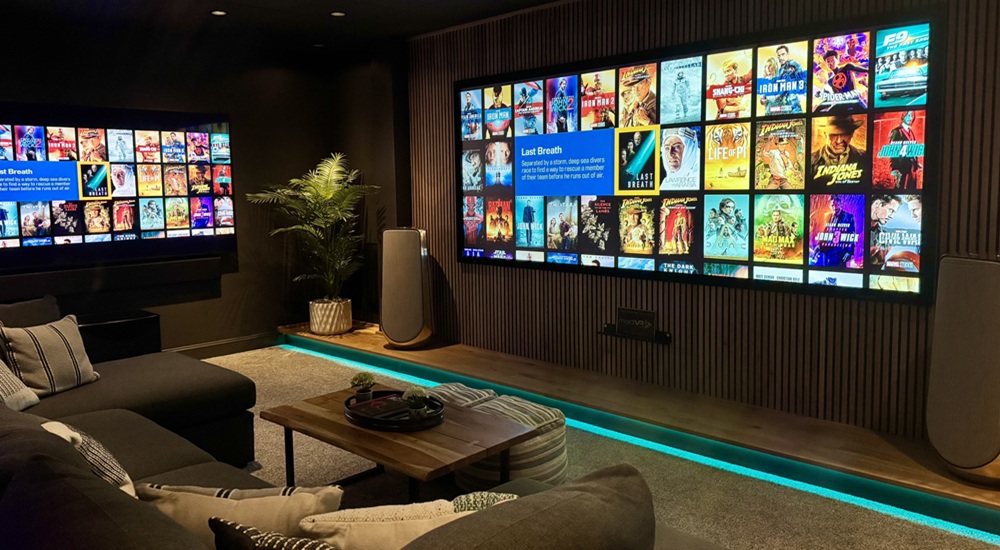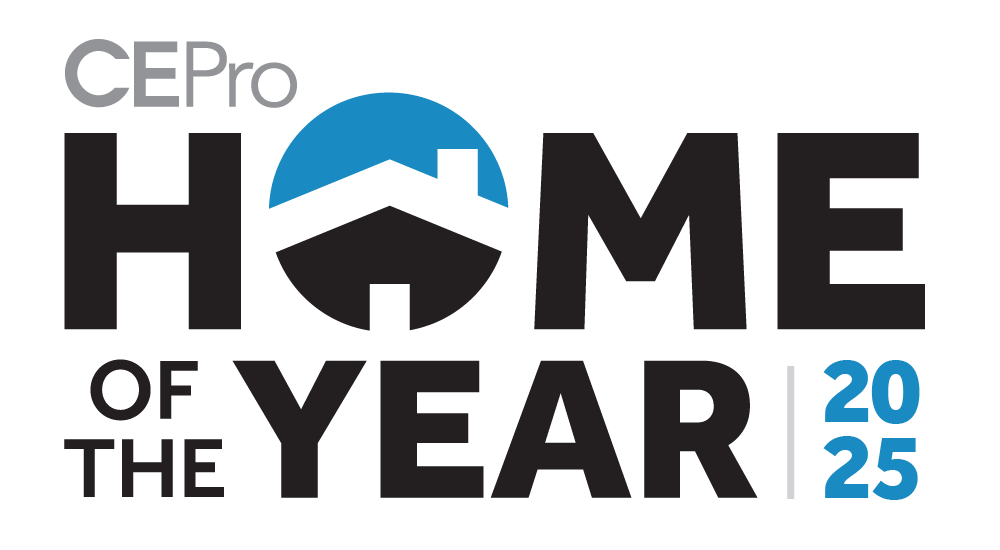After years of shifting preferences and pandemic-driven redefinition of what “home entertainment” means, the dedicated home theater is no longer a nostalgic luxury in 2025—it’s a market in resurgence. And it’s not alone. Multipurpose media rooms, immersive audio, projection systems, and even microLED are making deeper inroads into residential projects.
The 2025 CE Pro Home Entertainment Deep Dive survey offers a comprehensive look at how integrators are designing, selling, and installing AV spaces today. The data shows a maturing market where clients are investing more thoughtfully, and where dealers are evolving their offerings to meet new expectations.
Whether you focus on high-end private theaters, family-friendly media rooms, or hybrid outdoor entertainment installs, this year’s findings show one thing clearly: clients want cinematic experiences, and they’re willing to invest in systems that deliver them.
Market for Dedicated Home Theaters Remains Strong, But Growth Slows

Denver-area integrator QAV gave CE Pro a tour and home theater demo at their local showroom before CEDIA Expo 2024 got started.
One of the most surprising stories in last year’s report was the market comeback of the dedicated home theater. That momentum largely held through 2024, though some signs of cooling are emerging. The median number of dedicated home theater installs declined slightly from 5 projects in 2023 to 4 projects in 2024, representing a 20% year-over-year decrease. Still, 30.8% of respondents reported completing 11 or more dedicated home theater projects, up from 25% the year before.
The pricing landscape, however, remains robust. The median price point for a dedicated theater stayed steady at $62,500, matching 2023’s figure. That plateau follows a dramatic 43% jump between 2022 and 2023, indicating the market may be normalizing at the high end.
Dedicated theaters are still outfitted with impressive technology. Three-quarters of integrators reported installing six or more surround-sound loudspeakers, with 41% installing nine or more to support Dolby Atmos, DTS:X, and Auro-3D formats. Full immersive audio setups were included in 58% of projects, down from 88% the previous year, but still reflecting significant demand.
Tyson Rabani, CEO of Denver-area integration firm QAV, says the company is seeing increased interest for dedicated theater spaces, which he attributes to a remodeled showroom that includes a high-end theater.
CE Pro took a tour of the showroom last September while at CEDIA Expo 2024 and sat in on a theater demonstration, and the experience was indeed eye-opening. The theater included an 11.1.6 Dolby Atmos system featuring L-Acoustics speakers, Barco Residential projectors, MadVR video processors, and a Kaleidescape Strato player.
“With Spatial Audio and music tapping into Dolby Atmos, we see these spaces becoming even more popular as time moves forward,” Rabani says.
Multipurpose Media Rooms on the Rise
The market for multipurpose home theater spaces saw a notable rebound in 2024. The median number of installations climbed from 5 in 2023 to 8 in 2024, a 60% year-over-year increase. This recovery follows a dip in 2023 when integrators reported scaling back on multipurpose rooms in favor of higher-ticket dedicated theaters.
The median project price remained consistent at $37,500, a figure that had jumped 20% between 2022 and 2023. Integrators report that clients continue to invest more heavily in these rooms, often combining gaming, streaming, and casual movie viewing into a single space.
Related News: JBL’s Latest Soundbar Comes with Detachable Speakers for Diverse Arrangements
Nearly 40% of dealers said they completed 11 or more multipurpose installations in 2024. Only 11.5% of respondents reported not doing any multipurpose rooms last year, a small drop from 16% the year before.
Constantinos Sandoukas, founder and CEO of New Jersey custom integrator frayednot, says customers like the flexibility of multipurpose room media space.
“Everybody is really leaning towards utilizing space to maximize functionality out of it, more than anything else.”
Similarly, North Carolina-based integration firm SoundVision also finds that multipurpose rooms are becoming popular, says Chief Operating Officer Michelle Ferlauto. These spaces are designed to transition between movies, gaming, and everyday living.
“These rooms offer greater design flexibility and are often easier to integrate into main level living areas, making them a natural fit for how families are using technology today,” Ferlauto says.
A Snapshot of Home Entertainment Technologies
This year, CE Pro analyzed how frequently integrators include various technologies in their theater projects. The data reveals a clear divide between “core” technologies, defined as those used in over half of all projects, and those that are becoming more niche or optional.
Subwoofers, Architectural Speakers, Immersive Audio Top Out
According to 2025 market data, subwoofers, remotes and touch panels, architectural speakers, and immersive audio technologies are some of the most common technologies typically found in home theater installs, which isn’t that surprising.
However, the data also signals a shift toward large-format TVs and video walls instead of only projectors. Both hovered around 60% core usage, indicating that the choice between flat panels and projectors remains situational.
MicroLED screens and video walls like Samsung’s The Wall or similar offerings from LG and Just Video Walls may also be on the rise, but they are somewhat of an unproven residential technology due to relatively low adoption.
In fact, CE Pro’s 2025 home entertainment market survey reflected that notion, with just 32.5% of respondents saying they would, without a doubt, suggest a videowall for a dedicated home theater. Another 30% indicated that it would be on a case-by-case basis, and 27.5% said they would lean toward traditional theater options like projectors. Another 10% flat out said they won’t install those screens.
Technologies on the downswing were Blu-ray players, starfield ceilings, and freestanding speakers, suggesting that the industry continues to prioritize clean aesthetics, simplified control and immersive experiences.
Lack of Support, Affordability Remains Biggest Hurdle for Video Walls in Home Theaters
Integrators we talked to haven’t ruled out video wall technologies but have largely said there needs to be better support and a lower entry cost, as these screens alone are well over six figures.
Sandoukas says he has done the due diligence of responding to a client’s wish for something other than projection for a home theater install but wasn’t satisfied with the level of support for these very expensive products.
“Support is the most important piece of the puzzle,” Sandoukas says. “You need to know who’s in your corner.”
Without that support, integrators run the risk of selling one of the most expensive pieces of home technology available only for it not to work in the way it was intended. That could put an integrator’s reputation at risk, he says.
Ferlauto of SoundVision, meanwhile, says the company has invested in high-end video processing technologies, so it remains ready to jump on the videowall trend if it does catch on. For now, the company prefers to install projectors.
“The clientele just may not be ready for the price tag and limited warranty options compared to traditional configurations with projectors,” Ferlauto says.
Room Location Insights and Integration Trends

New Jersey integrator frayednot specializes in high-end home theater systems. Image/frayednot
When looking at room usage by volume rather than presence, the 2025 home theater market report reveals a more nuanced picture of where integrators are focusing their home theater efforts.
Dedicated Home Theater Rooms Comprise Biggest Bulk of Projects in 2025
Dedicated rooms dominate with an average of 78.5% of theater projects, reinforcing their continued relevance despite broader multipurpose trends. Multipurpose rooms follow closely at 69.5%, reflecting strong demand for flexible spaces that combine entertainment, gaming, and everyday living.
Basements, which are the traditional location for home theater projects, accounted for 45.6% of installs, suggesting that clients are looking for these immersive cinema technologies to be a more visible part of their home.
Outdoor spaces are also increasingly targets for home entertainment systems, accounting for 44.5% of installs.
This volume-weighted view shows that while dedicated and hybrid rooms are nearly ubiquitous, integrators are also distributing a significant portion of their work across a wider range of residential environments.
Hybrid Systems on the Rise
When asked what percentage of their theater projects were part of a whole-house AV or control system, 21.6% of integrators said 26% to 50% of installs were integrated. Another 17.6% said all of their projects were integrated into full systems, while 15.7% reported completely standalone theaters.
This data shows that while fully integrated systems are common, a growing percentage of dealers are designing hybrid solutions, especially as media rooms are added to homes in phases.
“Today’s clients increasingly see technology as something that complements or enhances their daily living spaces rather than something to tuck away — a shift driven by advances in lighting design, more décor-friendly audio solutions, and integrated shading systems,” Ferlauto says.
Integrators are relatively split on tying the entertainment system into a whole-home AV system, but that largely depends on the installation. Multipurpose media rooms and family rooms outfitted with large screens and sound systems are absolutely integrated into the home’s AV systems, but some don’t see the need to tie the dedicated, traditional theater room into the system.
“Why not make it an extension of everything else already happening in the home?” Rabani asks.
Seating Trends Remain Mixed
The average number of seats in a dedicated theater remains modest, with 46% of projects having four to six seats, and 34% having seven to 10 seats. The remaining respondents were split among the 11-plus seat theaters or rooms with fewer than three seats.
This relatively even distribution suggests dealers are balancing comfort, budget, and room size rather than pushing large seat counts across the board.
Integrators report seeing some competition from direct-to-consumer seating brands with aggressive online marketing, but CEDIA-channel furniture providers continue to be their go-to partners when it comes to home entertainment seating.
The number of seats largely depends on family size, according to Sandoukas, who says one of his clients has more than 20 grandchildren, so their home theater room has at least 14 seats.
On the flipside, another client, a producer, requested just one seat in his theater room.
According to Rabani, the seven-to-10 range is the “sweet spot” for most of QAV’s clients, but does admit that the preference for fewer seats reflects the shifting home theater market landscape in 2025 to more multipurpose spaces.
“Small spaces equals fewer seats,” Rabani notes.
Most Important Considerations in Home Entertainment Projects
The survey also asked integrators to rank the most important technologies and features when it comes to specifying home theater systems, from both their own professional priorities and what they believe clients care most about. The results reveal some key alignments, but also a few surprising disconnects between what dealers emphasize and what homeowners truly value.
Integrators Focus on Equipment Reliability, Manufacturer Support
For integrators, the top priorities were video quality, audio quality, and equipment reliability, with video topping the list for the second year in a row. Rounding out the top five were equipment availability and manufacturer support, reflecting ongoing supply chain sensitivities and the importance of dependable vendor relationships. While these categories make sense from a technical standpoint, they may not always align with what creates the most compelling client experience.
Interestingly, aesthetics, price, and feature sets fell into the middle of the pack for dealers, while brand name and in-home vs. theatrical release windows ranked among the least important considerations. This suggests that integrators are primarily focused on performance and dependability over marketing appeal.
The integrators we spoke to largely agreed with these results, saying reliable audio and video technologies should command a large portion of the budget. Ferlauto says SoundVision’s designs theater systems with top-end, proven, reliable systems.
“We’re investing where it matters most to integrators and clients alike,” she comments.
Rabani, meanwhile, says video quality should not be the highest item on the list.
“Homeowners will get far more ROI on other categories,” Rabani says, suggesting that spending more on audio quality will provide more value.
Clients Expect Cinema-Like Surround Sound
On the client side, integrators reported that a cinema-like surround sound experience was the top customer priority, followed by ease of use, multi-purpose functionality, and clean, attractive design. Features like strong bass, high-res audio support, and price also ranked highly. These results show that while integrators may lead with technical specs and system stability, clients care most about how a system sounds, feels, and integrates into their lifestyle—particularly in shared spaces like family rooms or open-concept great rooms.
From a customer perspective, immersive cinema-like features and ease of use are extremely important. However, ease of use should perhaps be ranked atop the list, according to Sandoukas.
“Ease of use is going to be number one for us,” Sandoukas states.
However, Sandoukas makes a compelling case for why audio quality should take precedence over video quality in home theaters. He draws an analogy to driving a high-performance car: you might admire the car’s looks at first, but the real value and excitement comes from experiencing how it drives. Similarly, in a home theater, the video may deliver the initial “wow factor,” but it’s the sound that truly immerses you and makes the experience memorable.
He also emphasizes the difference between surround sound “experience” and true audio quality. Many clients are impressed just by having multiple speakers around them, even if they’re poorly placed or acoustically imbalanced. It signals a step up from a basic TV or soundbar setup. However, Sandoukas argues that true theater-grade sound requires proper design: dedicated channels, dialog clarity, left-right separation, and room setup. That level of quality fundamentally changes how the user feels in the space.
“Immersive audio makes them feel like, ‘Now, this is the theater,’” Sandoukas relays.
Home Theater Market Outlook for 2025
Looking ahead, integrators remain optimistic about the home entertainment market, even as some areas show signs of leveling off. While immersive audio adoption dipped and dedicated theater install counts declined slightly, most respondents expect business to either hold steady or grow. According to the 2025 survey, 39.2% of integrators forecast no change in theater-related revenue, while 43.2% anticipate growth—with the largest group expecting gains in the 6% to 10% range. Only 17.6% expect any form of decline. On average, dealers project a 3.5% increase in the home theater market for 2025, mirroring last year’s outlook.
This tempered optimism reflects a maturing market and one where integrators are focusing less on volume and more on value, tailoring solutions to fit increasingly diverse room types, lifestyles, and aesthetic expectations. Technologies like microLED, wireless audio, and AI-powered room correction may still be in early stages, but integrators are watching them closely. Immediate growth is being driven by improved design, higher performance standards, and a growing demand for seamless integration across the home.
As clients seek theater-like experiences that blend into multipurpose spaces, integrators who emphasize user experience, reliable system design, and clear value propositions will be best positioned to thrive. Whether it’s a high-performance dedicated theater in a luxury home or a flexible entertainment zone woven into a great room or basement, the future of home cinema looks to be one of strategic evolution, not reinvention.
Keep Reading:
Check out our guide on what the experts say is needed in building a modern home theater system
Look through some past highlights with 34 high-end home theater projects to impress and inspire
Or see what receivers we recommend for building that killer sound system
















